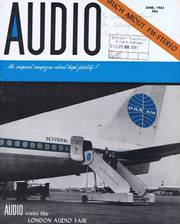1961 war Stereo für "jedermann" bereits 2 Jahre alt
In der US-AUDIO in Heft 06/1961 schreibt der Kolumnist, was es bei den neuen Stereo-Kopfhörern, also den "stereo" headphones für Neuerungen gibt und wie man damit umgehen sollte oder könnte.
Die Quelle : AUDIO E.T.C. by Edward Tatnall Canby
.
THOSE "STEREO" PHONES AGAIN . . .
(nochmal mein Senf über diese Stereo Kopfhörer)
I am really not happy about this to-do over the so-called "stereo" headphones. I have incurred the annoyance of a number of manufacturers of two-channel phones by suggesting what is surely the plain truth, that these phones do not give a stereo sound, but rather a binaural sound, (each channel going exclusively to one ear) which is more or less realistic according to the widely varying methods of stereo recordings now being practiced.
The sound may be lovely, exciting, a superb new sensation, it may be far superior to mono sound through headphones, and indeed it is. But it isn't stereo, and that is that.
Yet, for solid commercial reasons, the name stereo being what it is these days, this wrong terminology goes right along. I'm looking at an ad for a complete component music system right now, from a large metropolitan music store.
Stereo amplifier/FM tuner. Stereo speaker system, two separate units. Stereo turntable, plays stereo and monophonic records. And stereo headphones. "If you've never heard stereo through quality headphones, we know you're in for a thrill."
Very possibly. I don't mean at all to split hairs, nor to run down the genuine pleasure which many people have found in this "stereo" listening. Indeed, I've always been a headphone man, as many reader knows, and I'm frankly delighted that this very useful form of listening has staged such an unexpected comeback.
"phones" - Bislang ein Schreckgespenst für jeden Verkäufer
For years, the mere idea of headphones had been anathema to any salesman - only libraries and laboratories, schools, language centers and the like have used the devices, for purely practical reasons. But for home enjoyment - heavens no! Not commercial.
Well, they are commercial now, and a good thing. As I've already suggested, when home recording enthusiasts begin to discover the absolutely astonishing qualities of true binaural recording, listened to only via earphones (you'll need batteries of them, for the whole family), then I think the two-channel phone business is really going to spurt. The time is near enough - it's practically now. This particular plug of mine is absolutely hoary with age by this time.
Meanwhile, there are stereo recordings and there are 'phones. I keep receiving a steady spate of inquiries as to that "Bauer circuit" that converts headphones into simulated stereo receptors, and have dutifully sent them on to Mr. Bauer; but I have not heard further as to available commercial versions of his simple circuit.
It seems to me that the answer to the whole question of "stereo" headphone listening is to be found in this circuit. Just install it in your phones - or your tape recorder, as an alternative stereo amplifier 'phone output - and then go right ahead and call the 'phones stereo. Correct.
Was klingt gut über Stereo-Kopfhörer ?
What sounds good and what doesn't via the "stereo" 'phones is a quite interesting question. Stereo has many forms today and only the basic fact that two channels of sound are heard through two loudspeaker systems holds them all together.
In the miking, the sky's the limit - from two mikes inches apart and built into the same case all the way out to those elaborate multi-mike five-dimensional set-ups that are now used, mainly in this country, for operas and the like. (One recording session I saw had about forty operating mikes, including a separate mono network.)
Listening is a subjective thing in respect to the effect of stereo recording via 'phones. Some like it, some don't. (Even true binaural recording has a remarkably different impact on different people. I've been recording my own Canby Singers in binaural as a rehearsal aid - some singers just say umph at the earphone playback, others, when the 'phones are put on their heads, simply go straight up in the air and yell in amazement!)
It is thus quite likely that you may, indeed, be in for a thrill, as the ad says, when you try your first 'phones. Or you may merely be mildly amused. Some of you may even be distressed, as I have been, by unreal and "out of focus" effects, as described in my earlier discussion.
What I would like to add here is merely that the effects upon the ears vary greatly from one recording to the next, according to the microphoning used. None of the microphone systems were intended for reproduction with one channel exclusively going to each ear; all were meant to be heard via the cross-relating spread of stereo speakers, each ear hearing both speakers, as disparate sound sources in space.
But if you treat those mikes as surrogate ears, which is what happens in earphone listening, you may by accident or chance receive a very interesting signal. Or a very garbled and nonsensical one. It all depends.
Cross-Mike and M-S - die Mikrofone bei Stereo
I suspect that the European stereo recordings that are made via the M-S system, two mikes in one case plus a matrixing circuit, or by the simple cross-mike arrangement, two mikes at an angle and close together, will provide some very realistic
binaural listening - perhaps better than the actual stereo via loudspeakers.
(I am not very enthusiastic about this rather mild stereo, where the two-channel effect through speakers is so genteel as to be an almost inaudible step away from straight mono sound.)
Two mikes in this European arrangement make two tolerably good and well-placed ears, and that's all you need. It sounds terrific! (fürchterlich)
Indeed, recordings of this sort could well account for much of the genuine pleasure reported by earphone "stereo" listeners, and for the lack of unpleasantly noticeable falseness or fatigue effects. These listeners, to be sure, aren't hearing stereo; but they are hearing something even better, real binaural, or a very good semblance of it.
On the other hand, a recording made via twenty or thirty mikes, in and out of isolation booths, blended through two-channel reverb, artificial or otherwise, is just not binaural in any conceivable sense! Like trying to look at a scene through one of those new Japanese kaleidoscopes. Multiple images, overlapping, beautiful but - at least in this sort of fancy stereo sound - incomprehensible.
Die Wahrheit - eine Analogie ist gefährlich
To tell the truth, the analogy is dangerous, because in the kaleidoscope you do not usually try to discern reality of any sort (though you can, if you work hard at it); whereas in "stereo" listening via 'phones you are necessarily trying hard to create a mental image of a musical performance, as we always do in any listening to reproduced music - and you are fighting against a raft of dizzy, incompatible, contrary-minded sounds, near and far, throwing the two ears out of gear and every which way. Exciting, but quickly exhausting, conducive to severe ear strain if your listening imagination is at all subtle.
Come to think of it, the way to fix up your 'phones (you manufacturers and you home tinkerers) is to install a variable Bauer circuit, adjustable to compensate as well as possible for these large differences in stereo recording.
Leave it to Mr. B. to cite the variables; maybe an on-off switch would be plenty. Variable or no, though, I don't honestly think you should rest your 'phones in peace on your head until you have figured out this little problem some way or another. Worth your attention.
Let me add a quick and necessary postscript: In terms of loudspeaker listening I am all in favor of the highly tricked-up stereo now being used in some classical recordings and feel that, though sometimes it goes too far, in general the tricks have added a great deal to the purely musical effectiveness of the stereo medium.
The development is reasonable and honest, for we must not forget that all recording is based on illusion, via the unique laws that apply to the recorded medium. We do not try for a literal concert sound, nor for an exactly transcribed "live" performance, but rather for the soul of that performance, the meaning and sense of it, in terms of recording.
The "laws" of stereo are many and varied and more is found out about them every day. But nobody has yet claimed that for true binaural hearing we need more than two ears, and those more than a head's distance apart.
ENDE der US-AUDIO ETC Kolumne vom Juni 1961
.



